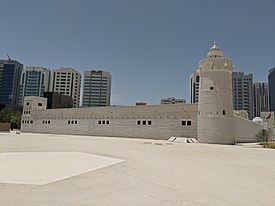

| Qasr al-Hosn | |
|---|---|

Qasr al Hosn in May 2019
| |
| Location | Sheikh Zayed the First Street |
| Coordinates | 24°28′57″N 54°21′17″E / 24.48239°N 54.35482°E / 24.48239; 54.35482 |
| Built | 1761 |
|
Location of Qasr al-Hosn in United Arab Emirates | |
The Qasr al-Hosn (Arabic: قصر الحصن, Qaṣr Al-Huṣn, "Fortified Palace") is a historical landmark and the oldest stone building in the city of Abu Dhabi, the capital of the United Arab Emirates. It was designed by Mohammed Al Bastaki[1] and built in 1761.[2]

It is located along Rashid Bin Saeed Al Maktoum St[3] and is a part of the Abu Dhabi Cultural Foundation.[4]
Qasr al-Hosn, also known as the White Fort (originally not white in colour but painted bright white during 1976–1983 renovations) or Old Fort,[5] was constructed in 1761 as a conical watchtower to defend the only freshwater well in Abu Dhabi island.[2] The tower was later expanded into a small fort in 1793 by the then ruler, Shakhbut bin Dhiyab Al Nahyan, and became the permanent residence of the ruling Sheikh.[2] The tower took its present shape after a major extension in the late 1930s, aided by revenues received for granting the first oil license in Abu Dhabi.[6] It remained the emir's palace (hence the name Qasr al-Hosn, meaning Palace fort) and seat of government until 1966.[2] The fort has been developed several times and is now partially open to the public.[7][8]
The Qasr al-Hosn is currently the subject of extensive historical, archaeological, and architectural research.[4][9] The fort houses a museum displaying artifacts and pictures representing the history of the country.[5] It also has a range of weapons, used through the region's history, on display.[5]
Qasr al-Hosn festival is an annual 11-day cultural event staged on the grounds of the fort.[10][11] The fort is open to the public during the festival, including some of the restricted areas[11] and features live music and dance performances showing the UAE's cultural heritage.[8]
|
| |
|---|---|
| Cities and areas |
|
| Municipal regions |
|
| Government |
|
| Culture | |
| Transport |
|
| Infrastructure |
|
| History |
|
| Sister Cities |
|
24°28′57″N 54°21′17″E / 24.48239°N 54.35482°E / 24.48239; 54.35482